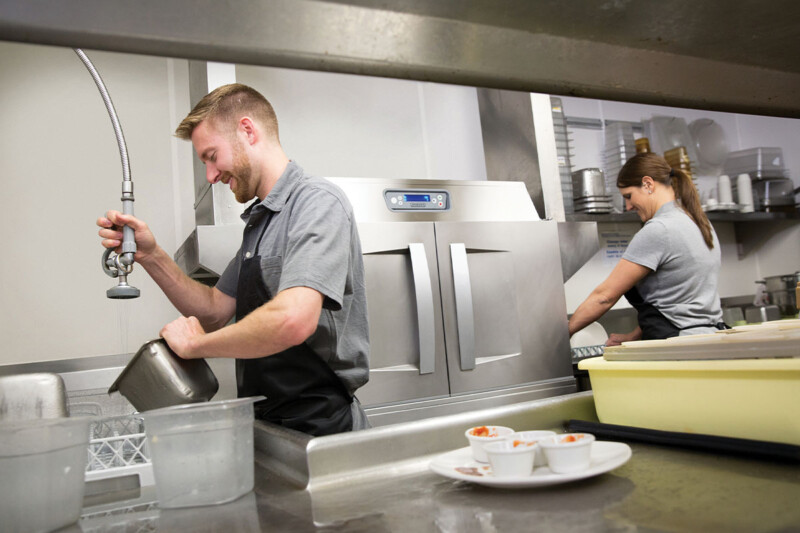How To Go About Choosing a Pressure Fryer
With oil and labor prices on the rise, today’s pressure fryers offer an economical way to cook fried chicken and other comfort foods.
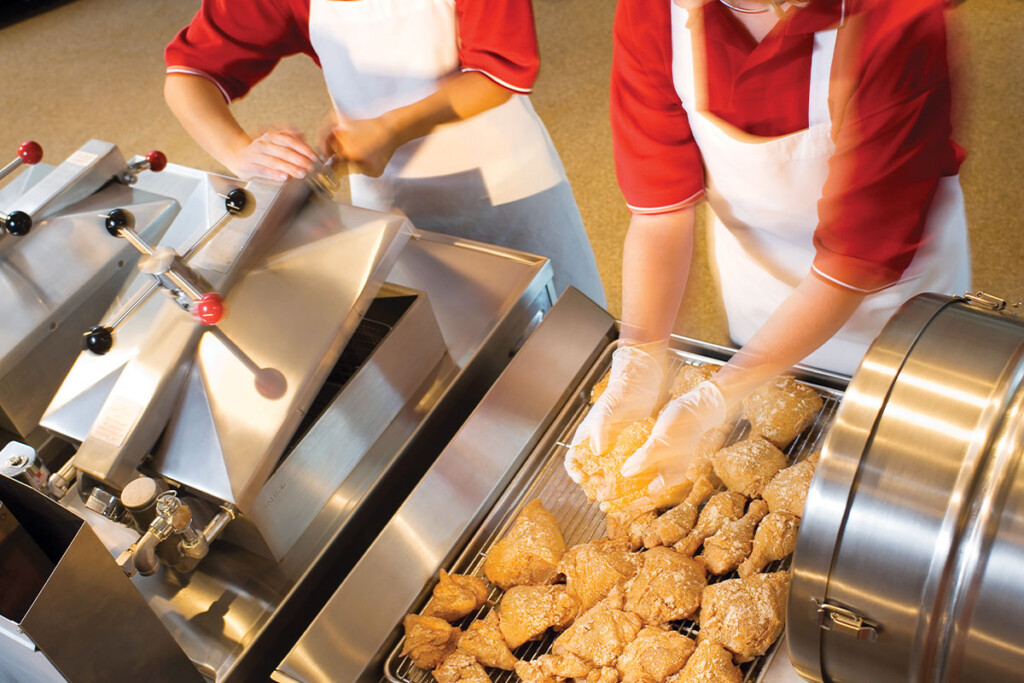
We’ve all seen the mouthwatering TV commercials for one fried chicken fillet sandwich after another, as quick-service operators battle for a share of the market in the “chicken wars.” Meanwhile, operators ranging from convenience stores to upscale restaurants showcase their own take on chicken tenders, wings and bone-in chicken, be it hot and spicy, brined in sweet tea or another style. While some operators prepare these crispy delights in open fryers, others specify a pressure fryer because of its unique ability to create a moist, juicy product in record time.

Pressure fryers create moist, juicy chicken sandwiches in record time. Operators also can use them for ribs, turkey, pork chops and other proteins. Just avoid ravioli. Courtesy of Broaster.
AN OPEN-AND-SHUT CASE
Fryers come in two main varieties: open vat and pressure. The latter operates under a tightly shut lid. As the food cooks, moisture is released and captured within the closed cooking cavity, building up pressure. At this higher pressure, water’s boiling point is elevated to over 240°F, allowing food to cook faster. In this closed setting, the food retains more moisture, resulting in a tender, juicy end product, with minimal flavor loss and less oil retention.
This pressurized environment is ideal for cooking chicken—creating a product that’s juicy on the inside and crispy on the outside. Popularized in the 1960s by Kentucky Fried Chicken’s Colonel Harland Sanders for cooking bone-in chicken, pressure fryers are now used by KFC, Chick-fil-A and other industry leaders for tenders, nuggets, fillets and more. Demand for fried chicken is surging, even at full-service restaurants like Yardbird Southern Table and Bar, which recently expanded to its sixth locale.
While chicken rules the roost when it comes to pressure fryers, the equipment works well with a variety of proteins, including ribs, turkey and pork chops. Thick potato wedges also come out tender and flavorful. For thin, crispy fries, operators generally prefer a conventional fryer. Beware that some foods don’t do well under pressure (picture exploding raviolis).
Compared with open models, pressure fryers cook about 10% to 30% quicker, manufacturers estimate, and at lower oil temperatures. That means increased throughput, which can be critical during peak times. Bone-in chicken typically takes 10 to 12 minutes for a four-chicken load; fillets and tenders cook in three to five minutes. Pressure-fried food boasts a long hold time, making it popular with grab-and-go operations, like grocery stores and convenience shops, and restaurants that cook ahead.
Pressure frying extends oil life. In an open fryer, oil is exposed to oxygen, which deteriorates shortening quality, requiring more frequent oil changes. With faster cook times at lower oil temperatures, pressure fryers also consume less energy.

A quarter rack basket system keeps product separate during the cooking process. Courtesy of Winston.
WELL-OILED MACHINE
One of the biggest expenses of pressure frying is the oil, with some fryer wells holding 75 lb. of this precious commodity. Shortening and cooking oil prices have surged in the past year, climbing 34.8% between June 2020 and June 2021, according to the U.S. Bureau of Labor Statistics’ Producer Price Index report. Add to that the labor costs of managing oil—filtering, refilling, cleaning and the associated employee training. In response, manufacturers have introduced several features to increase oil efficiency and ease oil management.
Perhaps the biggest game changer is automatic filtration after each frying load. Filtering extends the oil’s life, meaning less frequent oil changes and increased savings. It removes impurities, improving food quality and consistency. Nevertheless, many busy operators don’t filter as often as recommended by manufacturers, avoiding the task and the associated equipment downtime. One manufacturer boasts that automatic filtration—combined with other oil management features—on its premium model nearly quadruples oil life. Another maker notes that automatic filtration extends oil life one to three days on its newest line and estimates an associated labor savings of 15 to 30 minutes per day, a yearly savings of $910 to $2,730 per fryer in labor costs.
Still, some operators prefer not to invest in automatic filtration. With standard filtration, one filter can service multiple fryers. With automatic filtration, you’re paying for this upgrade with each fryer.
Some pressure fryers feature onboard oil reservoirs to top off oil levels safely, saving crew members from manually pouring shortening into a hot vat of oil, which can result in dangerous splash back. At least one maker offers an automatic top-off feature, with a sensor that detects when the oil level is too low. Consistent oil levels help with food consistency, particularly useful for multiunit operators. Of course, some operators prefer to have control over topping off.
HIGH-TECH BELLS AND WHISTLES
While the basic pressure fryer design has changed little over the years, manufacturers have added high-tech capabilities, including the ability to program in time-and-temperature settings for food products. One model accepts programs for up to 160 products, with information easily uploaded through a USB port, a time-saver for multiunit operators. Many models adjust the cooking time automatically to accommodate for varying sizes and temperatures of loads. Some double as data-trackers, allowing operators to monitor everything from food production to oil management.
Easy-to-use, full-color touch-screen interfaces on some models reduce training time and help crew members produce a consistent product across multiple units, no matter who is on duty. These models walk employees step-by-step through cooking, cleaning and other tasks—a valuable tool given the industry’s high turnover rate and the importance of operating a pressure fryer safely. Some models offer bilingual capabilities and allow operators to upload product photos to expand accessibility and ease-of-use.

Round fry pots offer uniform heat distribution and efficiency, with no corners for cold spots,according to the makers of these types of models. The market also offers rectangular designs. Courtesy of BKI.
SPECIFYING A MODEL
If you’re in the market for a pressure fryer, consider these specs:
SIZE. Pressure fryers come in a variety of sizes, with some cooking as little as two heads, or 16 pieces, in a batch and others handling eight heads, or 64 pieces. Find the right fit for your operation by examining your product mix and projecting how many items are needed per hour. Factor in whether you cook and hold large batches, or cook to order. For example, if you cook to order, two midsize units might serve you better than one large one. Consider the floorspace under your hood, and compare the throughput per square foot of different models.
OIL-TO-CHICKEN RATIO. Given the high price of oil, compare how much of this commodity is required per pound of chicken. One manufacturer redesigned its fry pot a few years ago to cook with 25% less oil. Factor in the oil life in a particular fryer, looking at how often oil needs to be filtered and changed.
ENERGY EFFICIENCY. Manufacturers continue to engineer ways to make pressure fryers more efficient, with one company in the midst of rolling out an energy-efficient series featuring a new burner system. There is no Energy Star category for pressure fryers, so you’ll need to look closely at the specs to make a comparison. Consider local energy prices when choosing between gas and electric fryers, and check to see if local utility companies offer any rebates.
PRESSURE LEVEL. Most pressure fryers operate at around 12 psi. One manufacturer notes that its off-the-shelf models cook at 3 psi, but it customizes units that operate up to 14 psi. Products cook slightly faster at a higher psi, but a low psi offers an extra safety fallback. Because a pressure fryer operates by building pressure as moisture is released from food, a less-than-half-full fryer may not rise to your specified pressure level. Some models offer a feature that adds pressure when cooking small batches to help reach the optimum level.
ROUND VERSUS RECTANGULAR. Manufacturers of round fry pots assert that the circular design offers uniform heat distribution and efficiency, with no corners for cold spots. Meanwhile, one competitor making rectangular pots contends the shape offers a more thorough and even cook as a result of random tumbling and turbulence reducing cold areas. You be the judge. Visit distributor demo kitchens, test-run different models and dig into some fried chicken to determine what works best for your operation.
Factor in the oil life in a particular fryer, looking at how often oil needs to be filtered and changed.
Fry It Up
Some of the latest pressure fryers come with automatic oil filtration, efficient burner systems and more. Take a look.
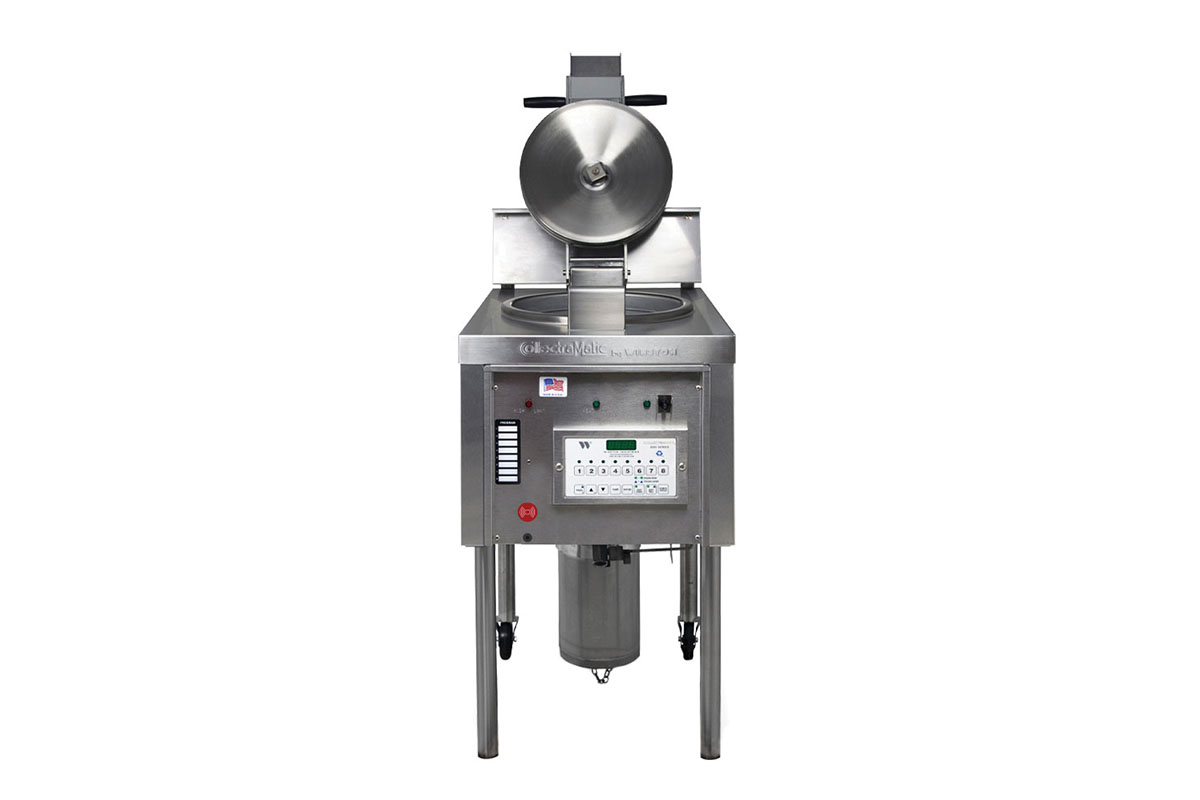
Winston
MODEL: Collectramatic LP46
DIMENSIONS: 20-in.W x 30-in.D x 50-in.H
PRODUCT CAPACITY: 14 lb.
FEATURES: A large cold zone lets the fryer perform up to 30 cook cycles without fi ltration, extending oil life and reducing filtering; the controller offers flex time for varying sized products and an oil management system.
WEBSITE: winstonfoodservice.com
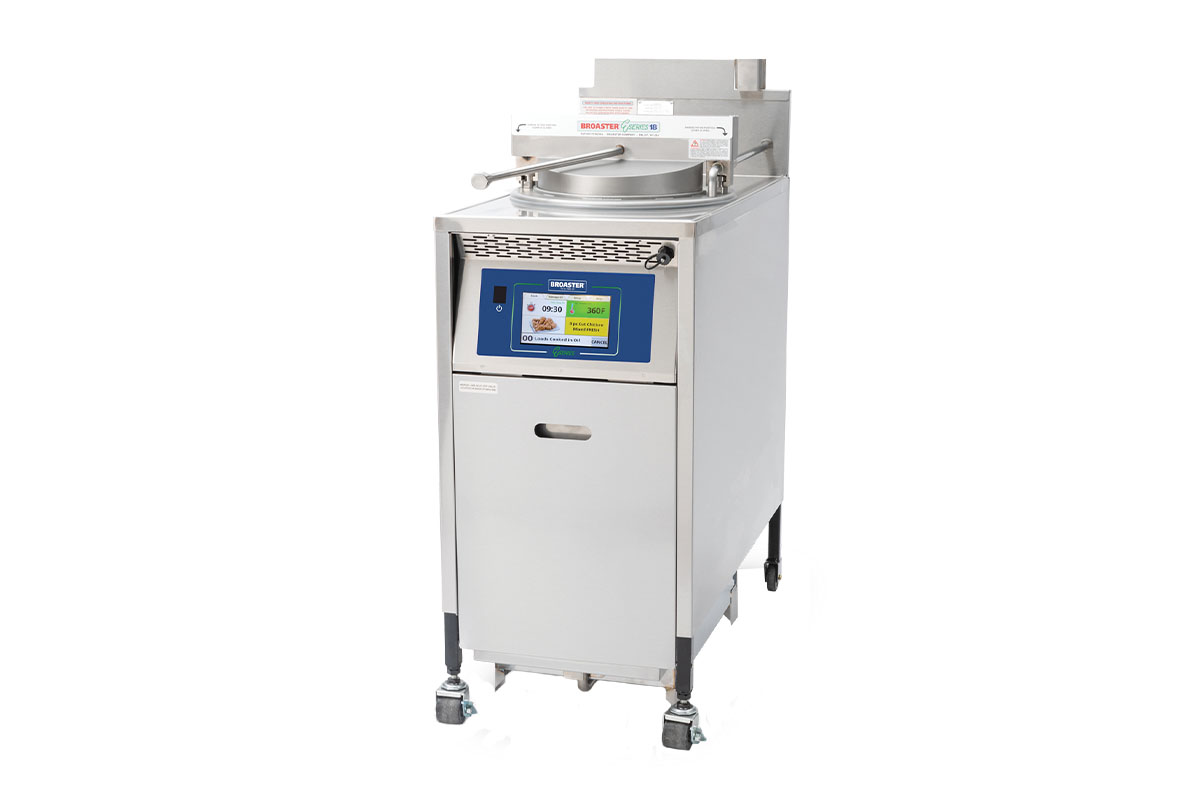
Broaster
MODEL: E-Series 18
DIMENSIONS: 20½-in.W x 38-in.D x 46-in.H
PRODUCT CAPACITY: 14 lb.
FEATURES: An efficient burner system helps the unit to use about 23% less gas compared with the company’s 1800 model; it comes with automatic oil filtration between cycles and onboard oil replenishment.
WEBSITE: broaster.com
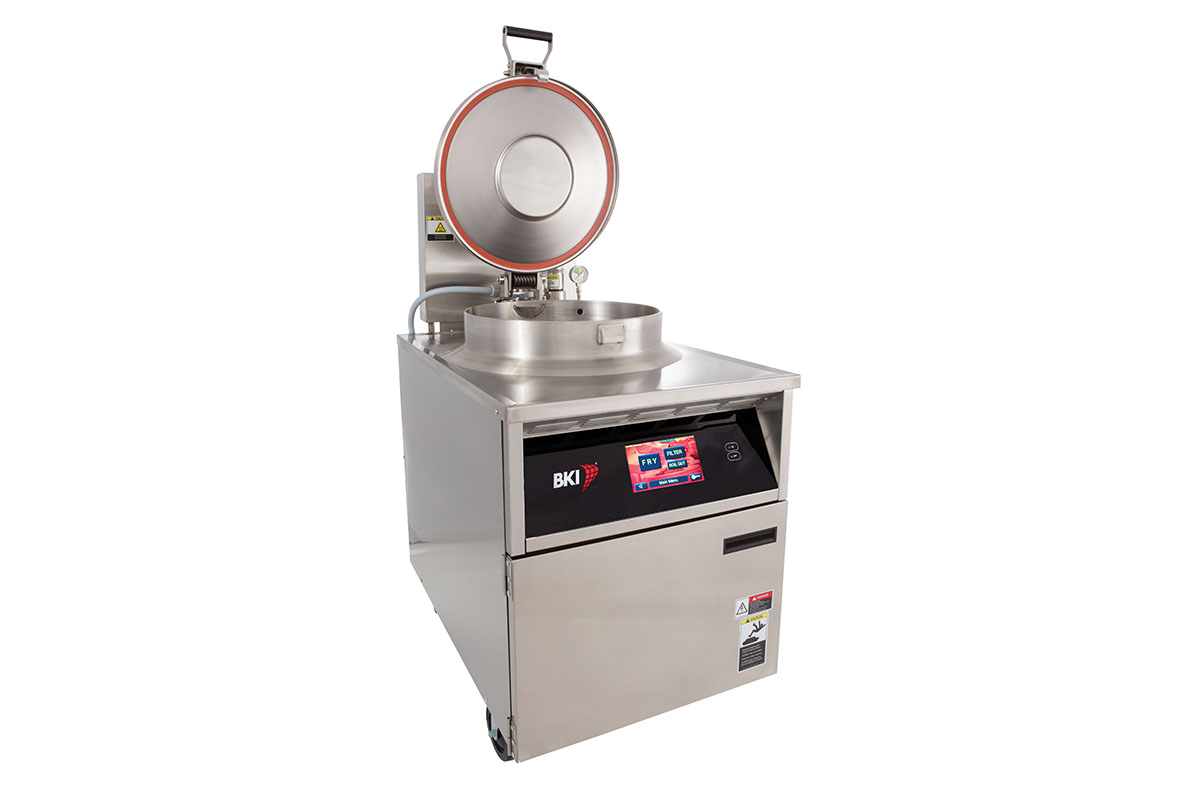
BKI
MODEL: FKM-TC
DIMENSIONS: 24¼-in.W x 38-in.D x 49½-in.H
PRODUCT CAPACITY: 24 lb.
FEATURES: Touch-screen controls come with a training program so new employees can quickly learn how to manage operations; the built-in filtration system extends oil life.
WEBSITE: bkideas.com
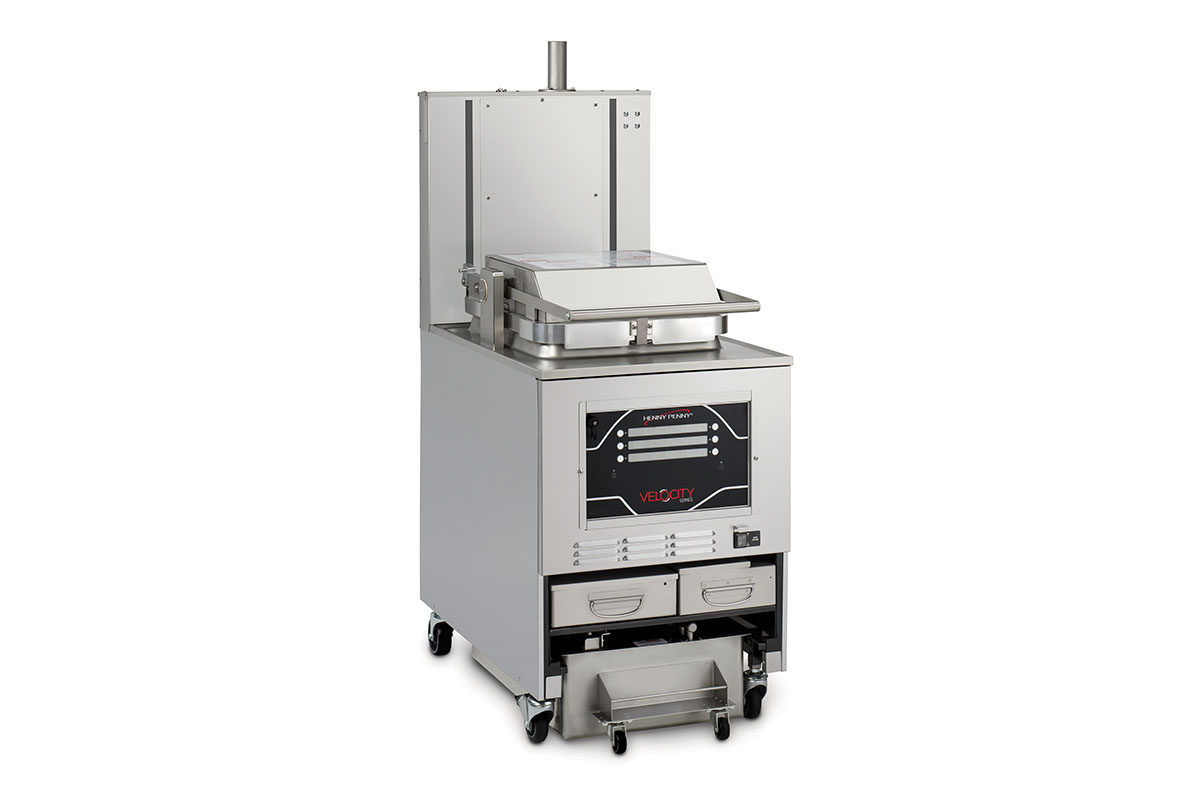
Henny Penny
MODEL: Velocity Series
DIMENSIONS: 24-in.W x 41-in.D x 62-in.H (PXE 100)
PRODUCT CAPACITY: 8 heads (about 28 lb.)
FEATURES: The series cooks the same amount of chicken per load as the company’s previous high-volume fryer but with 25% less oil; units come with automatic oil filtration between cycles and automatic oil top off ; it accepts programs for up to 160 menu items.
WEBSITE: hennypenny.com
RELATED CONTENT
- Advertisement -
- Advertisement -
- Advertisement -
TRENDING NOW
- Advertisement -
- Advertisement -
- Advertisement -


